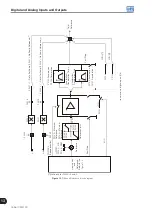
Faults and Alarms
15
CFW700 | 15-1
15 FAULTS AND ALARMS
The troubleshooting structure of the inverter is based on the indication of faults and alarms.
In a fault event the IGBTs firing pulses are disabled and the motor coasts to stop.
The alarm works as a warning to the user that critical operation conditions are occurring and a fault may occur if
the situation does not change.
Refer to the CFW700 user's manual chapter 6 - Troubleshooting and Maintenance, and the
of this manual to obtain more information regarding the Faults and Alarms.
15.1 MOTOR OVERLOAD PROTECTION
The Motor Overload protection is based on the use of curves that simulate the heating and cooling of the motor
in overload events, according to IEC 60947-4-2 and UL 508C standards. The fault and alarm codes for the motor
overload protection are F072 and A046, respectively.
The motor overload is given in function of the reference value In x SF (motor rated current multiplied by the service
factor), which is the maximum value at which the protection must not actuate because the motor is able to operate
indefinitely with this current value without suffering damages.
However, for that protection to act in an appropriate manner, the thermal image of the motor, which corresponds
to the heating up and cooling down times of the motor, is estimated.
The thermal image, in its turn, depends on the motor thermal constant, which is estimated based on the motor
power and number of poles.
The thermal image is important to allow that a derating in the fault actuation time be given, so that shorter actuation
times be obtained when the motor is hot.
This function applies a derating in the fault actuation time depending on the output frequency supplied to the
motor, because for the self-ventilated ones there will be less ventilation on the frame at lower speeds, and the
motor will be subject to more heating. Thus, it becomes necessary to reduce the fault actuation time in order to
prevent the motor from burning.
In order to assure more protection in case of restart, this function keeps the information regarding the motor
thermal image in the CFW700 nonvolatile memory. Therefore, after the inverter restart, the function will use the
value saved in the thermal memory to perform a new overload evaluation.
The parameter P0348 configures the desired protection level for the motor overload function. The possible options
are: Fault and Alarm, only Fault, only Alarm, and disabled motor overload protection. The actuation level for the
motor overload alarm (A046) is adjusted via P0349.
In order to get more information, refer to parameters P0156, P0159, P0348 and P0349 in the
.
NOTE!
In order to assure the conformity of the CFW700 motor overload protection with the UL508C
standard, observe the following:
The “TRIP” current is equal to 1.25 times the motor nominal current (P0401) set in the “Oriented
Start-up” menu.
The maximum allowed value for P0159 (Motor Tripping Class) is 3 (Class 20).
The maximum allowed value for P0398 (Motor Service Factor) is 1.15.
Summary of Contents for CFW700
Page 2: ......
Page 4: ......
Page 8: ...Summary...
Page 34: ...2 General Information 2 4 CFW700...
Page 38: ...3 About the CFW700 3 4 CFW700...
Page 56: ...7 Starting up and Settings 7 4 CFW700...
Page 58: ...8 Available Control Types 8 2 CFW700...
Page 78: ...10 VVW Control 10 8 CFW700...
Page 158: ...13 Digital and Analog Inputs and Outputs 13 28 CFW700...
















































